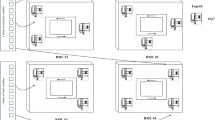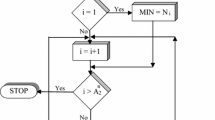Abstract
The identification of part families and machine groups that form the cells is a major step in the development of a cellular manufacturing system and, consequently, a large number of concepts, theories and algorithms have been proposed. One common assumption for most of these cell formation algorithms is that the product mix remains stable over a period of time. In today’s world, the market demand is being shaped by consumers resulting in a highly volatile market. This has given rise to a new class of products characterized by low volume and high variety. To incorporate product mix changes into an existing cellular manufacturing system many important issues have to be tackled. In this paper, a methodology to incorporate new parts and machines into an existing cellular manufacturing system has been presented. The objective is to fit the new parts and machines into an existing cellular manufacturing system thereby increasing machine utilization and reducing investment in new equipment.
Similar content being viewed by others
References
Akright W.T., Kroll D.E. (1998). Cell formation performance measures—Determining when to change an existing layout. Computers and Industrial Engineering, 34(1): 159–171
Chandrasekharan M.P., Rajagopalan R. (1986). MODROC: An extension of rank order clustering for group technology. International Journal of Production Research, 24(5): 1221–1233
Cormen T.H., Leiserson C.E., Rivest R.L.(1990) Introduction to algorithms. Cambridge, MA, MIT Press
Fu K.S. (1998). Syntactic pattern recognition and applications. Computers in Industry, 35, 101–108
Harhalakis G., Ioannou G., Minis I., Nagi R. (1994). Manufacturing cell formation under random product demand. International Journal of Production Research, 35(1): 47–64
Kao Y., Moon Y.B. (1998) Feature-based memory association for group technology. International Journal of Production Research, 36(6): 1653–1677
King J.R., Nakornchai V. (1982). Machine-component group formation in group technology: review and extension. International Journal of Production Research, 20(2): 117–133
Ko K.-C., Egbelu P.J. (2003). Virtual cell formation. International Journal of Production Research, 41(11): 2365–2389
McAuley J. (1972). Machine grouping for efficient production. The Production Engineer, 52, 53–57
Nair J.G., Narendran T.T. (1997). On the use of the asymptotic forms of the boolean matrix for designing cellular manufacturing systems—An improved approach. European Journal of Operational Research, 100, 429–440
Rajamani D., Szwarc D. (1994). A mathematical model for multiple machine replacement with material handling and relocation consideration. Engineering Optimization, 22(2): 213–229
Seifoddini H. (1989a) Single linkage versus average linkage clustering in machine cells formation applications. International Journal of Production Research, 16(3): 419–426
Seifoddini H. (1990). A probabilistic model for machine cell formation. Journal of Manufacturing Systems, 9(1): 69–75
Seifoddini H., Djasemmi M. (1997). Determination of a flexibility range for cellular manufacturing systems under product mix variations. International Journal of Production Research, 35(12): 3349–3366
Shafer S., Rogers D. (1991). A goal programming approach to the cell formation problem. Journal of Operations Management, 10, 28–43
Singh N. (1996). Systems approach to computer-integrated design and manufacturing. New York NY, John Wiley & Sons Inc
Tam K.Y. (1990). An operation sequence based similarity coefficient for part families formations. Journal of Manufacturing Systems, 9(1): 55–68
Venugopal V., Narendran T.T. (1993). Design of cellular manufacturing systems based on asymptotic forms of a boolean matrix. European Journal of Operational Research, 67, 405–417
Wicks E.M., Reasor R.J. (1999). Designing cellular manufacturing systems with dynamic part populations. IEEE Transactions, 31, 11–20
Wei J.C., Gaither N. (1990). An optimal model for cell formation decisions. Decision Sciences, 21(2): 416–433
Wong M.A., Lane T. (1983). A kth nearest neighbor clustering procedure. Journal of Royal Statistical Society B, 45(3): 362–368
Wu H.L., Venugopal R., Barash M.M. (1986). Design of cellular manufacturing systems: a syntactic pattern recognition approach. Journal of Manufacturing Systems, 5, 81–88.
1 http://www.math-info.univ-paris5.fr/~ycart/mst/mst031/Group10/first.html
2 http://people.cs.uct.ac.za/~bmerry/manual/algorithms/sorting.html
Author information
Authors and Affiliations
Corresponding author
Rights and permissions
About this article
Cite this article
Bhandwale, A., Kesavadas, T. A methodology to incorporate product mix variations in cellular manufacturing. J Intell Manuf 19, 71–85 (2008). https://doi.org/10.1007/s10845-007-0046-4
Published:
Issue Date:
DOI: https://doi.org/10.1007/s10845-007-0046-4




